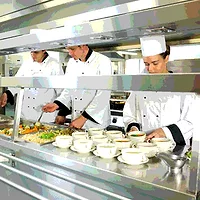Reducing safety risks in dairy products
The industry is focusing on developing new processes and technologies that have a significant impact on safety but a minimal impact on the product.

Ensuring consumer safety through innovative technologies that improve product safety is a critical priority for the dairy industry. Important pillars of a safe dairy product include having high-quality raw materials, proper storage temperatures, proper pasteurization and good sanitation procedures. Innovation is also key to this mission. Thanks to partnerships between dairy research centers, food scientists and the industry, new technologies are continually being developed and investigated to ensure that every dairy product is safe and wholesome.
Benefits of non-thermal processing
Today, the industry is focusing much of its efforts on developing new processes that have a significant impact on safety but a minimal impact on the product. Non-thermal processing technologies fit well into this category, as they are capable of removing or inactivating bacteria without the high temperature of traditional pasteurization.
For example, high pressure processing (HPP) uses extreme pressures like 87,000 pounds per square inch to inactivate bacteria and some enzymes. HPP can be utilized with packaged products and often results in a fresher flavor when compared to pasteurization in products such as juices. It can also improve shelf-life. Apart from improved food safety, non-thermal technologies may also allow for the removal of some preservatives, which is attractive to companies interested in clean label products.
Training employees on safety
The latest technologies are nothing without properly trained employees who understand good manufacturing practices (GMPs) and abide by them daily. From simple protective measures such as foot sanitizing stations to hairnets and lab coats, safety is the responsibility of every person in the plant. It’s also the role of safety managers to ensure that employees know the rules and are empowered to follow them.
It is essential that each employee understands the reasoning behind annual mock traceability, food defense programs and documentation of records. It is also important for managers to walk through the process for addressing a positive pathogen test and explain how employees can help during that situation.
Understanding the safety regulations will be essential as manufacturers continue to feel pressure from regulatory agencies and consumers to implement finished product testing protocols and additional measures to ensure that pathogens are not present.
Currently, the dairy industry relies on established food safety with critical components like GMPs, prerequisite programs, audits and environmental monitoring. However, there is a push for more rapid pathogen screening to help reduce turnaround time, improve food safety for consumers and reduce the number of very costly recalls.
Looking for quick answers on food safety topics?
Try Ask FSM, our new smart AI search tool.
Ask FSM →
Testing finished product
Challenges for finished product testing include the sporadic nature of pathogen contamination, the need to hold product until results are available and the fact that any positive results would require notifying the Food and Drug Administration. Regulatory organizations like State departments of health or agriculture and the FDA are already testing finished products at stores.
Some sectors of the food industry (e.g., fresh produce) have already been working with food testing labs to establish appropriate sampling plans of finished products and valid statistical criteria. Rapid multiplex polymerase chain reaction (PCR) detection is one such technology that has been implemented in some food processing facilities to provide an initial indicator for a possible microbiological problem.
Using multiplex PCR detection, a suspect product batch can be identified and then put on hold for further testing, or disposed of, if that is necessary, allowing for a quicker response to a potential pathogen issue. FSMA requires some verification of the food safety plan as well as validation of the plan, and finished product testing could be used for that verification purpose.
Using protective cultures
In the end, we live in a microbial (non-sterile) world that includes both helpful and harmful microbes. In recent years, some companies have decided to utilize this non-sterile environment to our advantage. Instead of developing new preservatives, they’ve developed or identified what are called “protective cultures,” or lactic acid bacteria that produce by-products like organic acids and bacteriocins that inhibit the growth of pathogenic bacteria.
Various protective cultures can be selected to inhibit the growth of different types of pathogenic and spoilage bacteria, as well as yeasts and mold. These protective cultures can be added along with the traditional starter cultures and can help to enhance the safety of products like cheese.
One of the benefits of this technology is that protective cultures are considered clean label, which has encouraged the use of such bio-preservatives, although a high concentration of organic acids in some products can cause off-flavors.
Though there are challenges along the way, industry, regulatory and academia are working together to continually develop processes and preventive controls that will ensure that dairy products remain a safe and wholesome part of the diet.
This article was originally posted on www.dairyfoods.com.









